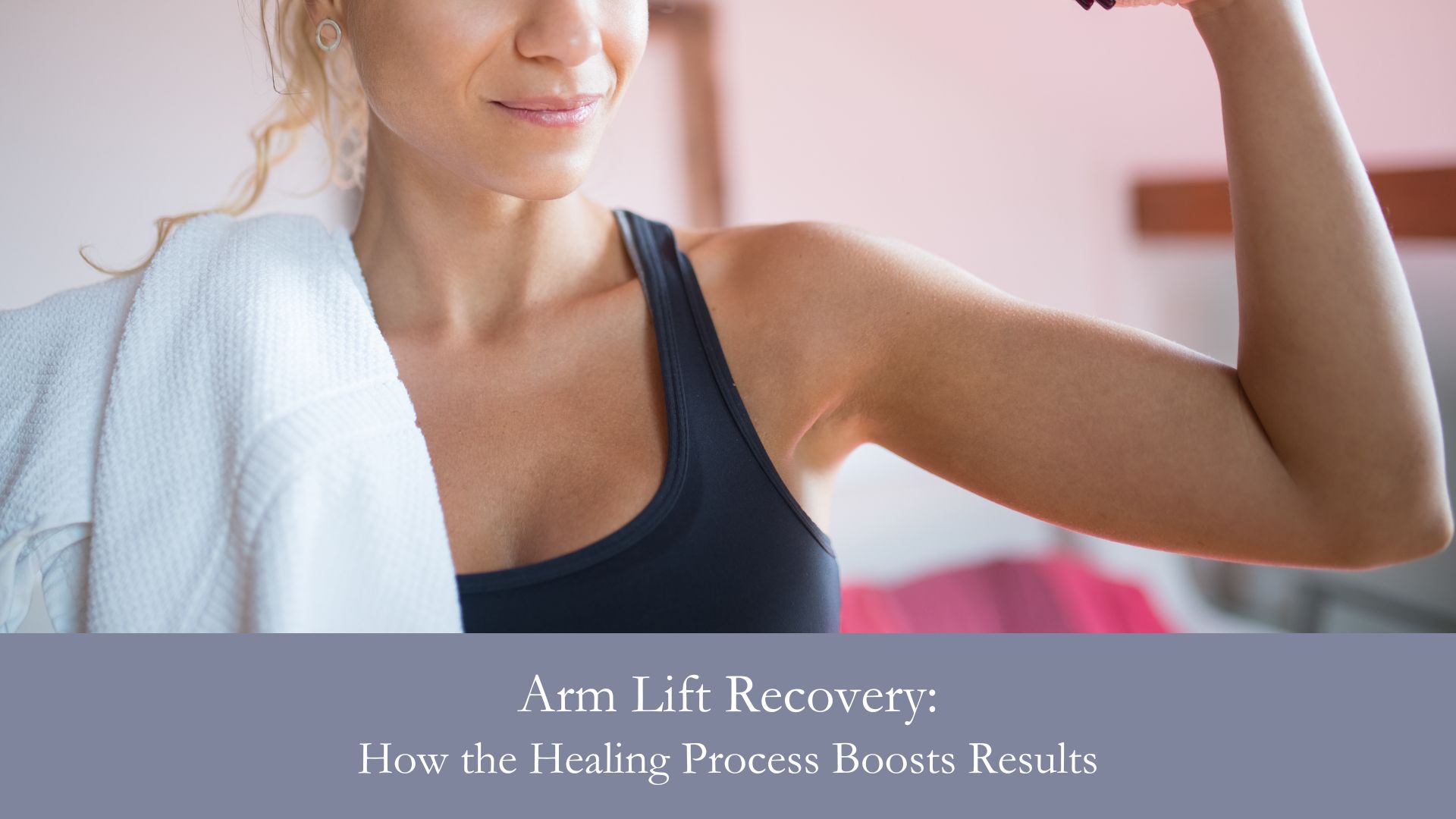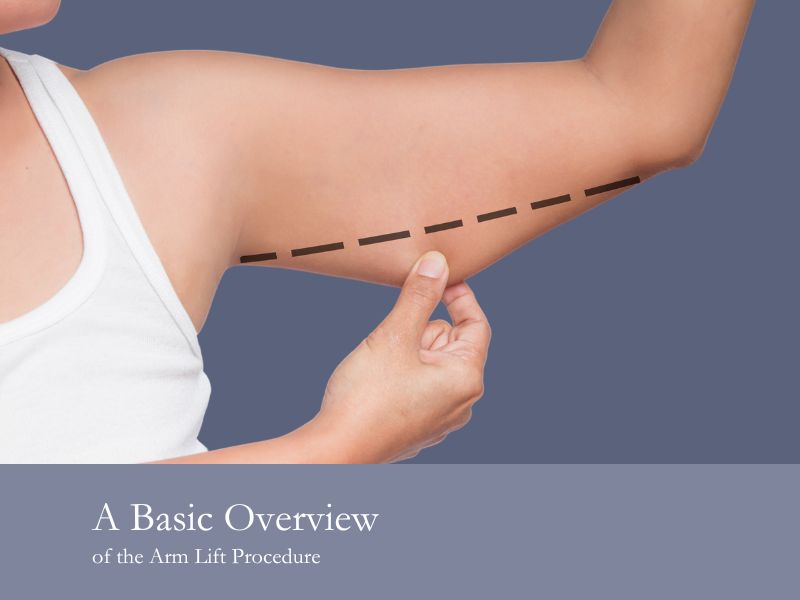The arm lift recovery process helps you create some of the most subtle, yet beautiful results for your upper arms. Failing to follow your surgeon’s advice closely could delay your recovery, worsen scarring, or increase your risk of complications.
How long is arm lift recovery? Whether you’re worried about getting back to work on time or managing leftover loose skin, we’ll walk you through common questions and concerns about the recovery process.
Table of Contents
A Basic Overview of the Arm Lift Procedure
Before we dive into the recovery process, it helps to understand exactly what you’re recovering from. Unlike arm liposuction’s more minimally invasive approach, an arm lift procedure tends to leave longer scars due to your surgeon’s incisions.
These incisions are vital for pulling, trimming, and contouring loose skin around your arm. They may or may not remove the occasional fatty tissue to promote a smoother appearance. If you need a large amount of fat removed, however, you’ll need arm liposuction instead of an arm lift.
Once the surgery is over, you’ll go through a complex recovery period that involves draining, scarring, and swelling.
What is the Average Recovery Time? A Step-By-Step Guide
The average patient will spend up to four to six weeks recovering from arm lift surgery. This process may end up a little shorter or a little longer depending on factors such as following your regimen, your age, and your body’s natural healing process.
1. Expect Mild Bleeding and Drainage From the Incision Sites
Your outpatient procedure will involve a mixture of pain medication, expectation management, and new habits. Your first order of business is to expect some bleeding and drainage from the incisions, a natural sign that your body is flushing out bacteria and healing.
The drainage should be mild and clear. If it smells funny or is an odd color like yellow or green, you could have an infection. Make sure to keep an open line of communication with your surgeon and update them on any unusual signs like pus, excessive bleeding, or unusually high levels of pain.
2. You’ll Receive a Compression Garment to Improve Healing
While your body can heal without compression garments, this tool is extremely helpful in reducing tenderness and discomfort for the next several days. These garments work by stimulating blood flow, reducing the risk of infection, and lowering painful swelling, a winning combination for a smooth recovery period.
Another reason surgeons provide patients with this garment is to enhance their cosmetic results. This firm, yet stretchy material helps firm up the remaining skin and create more shapely arms.
Your surgeon will provide strict guidelines on how to wear compression garments, such as temporary removal or putting them back on correctly.
3. You Need to Avoid Certain Activities and Movements for a While
The first week following surgery will require limited arm movement, so no arms elevated or laying on your side while sleeping. You’ll also need to avoid lifting heavy objects or performing strenuous exercises (like sports, cardio routines, or dancing).
The goal of these post operative instructions is to reduce the risk of opening up your incisions and potentially causing an infection. Your surgeon will also recommend you avoid tight, restrictive clothing to avoid rubbing on the incision sites and causing soreness or irritation.
While this period can feel a little tedious or frustrating — especially when you have things to do — it helps minimize swelling, pain, and setbacks. With plenty of rest, you give your body the ability to focus on stitching itself back together and feeling better than ever.
4. Report Unusual Symptoms to Your Surgeon Immediately
Over the next few weeks, you’ll notice various symptoms like bruising, tenderness, and gradual pain reductions. You need to keep a close eye on your symptoms to make sure no complications arise.
Unusual signs include (but aren’t limited to):
- Ongoing chest pain
- Increasing fever
- Excess twinging or stinging at the incision site
- Poor wound healing
- Swelling or bruising that doesn’t go away
Listen to your intuition. If you notice any symptoms that don’t seem right and aren’t going away, contact your surgical center. Your medical professional will help you figure out what’s causing issues and get you the help you need.
5. Gradually Ease Back Into Day-To-Day Activities
After four to six weeks, you should have little to no swelling or bruising left over on your arms. Your scars should be fully healed and your arms should take on a smooth and toned appearance. When you compare your before and after fat arms, you’ll be amazed at how much better you look and feel.
It’s important to note that leftover scars are common after a brachioplasty procedure, though you can fade these scars with dedicated skin treatments.
Frequently Asked Questions: Arm Lift Recovery
Thinking of trying body contouring to reduce sagging skin? Below are some of the most common questions beginners ask about the brachioplasty arm lift process.
How Long Do You Have to Be Off for an Arm Lift?
If you’re worried about missing work or school, plan for at least a week off to focus on your recovery. The next two to three weeks you can have limited activity such as walking or mingling with friends, but avoid strenuous exercise or lifting your arms.
How Long After an Arm Lift Can I Drive?
Since the upper arms will be swollen and tender, most patients need to wait at least two weeks before driving. However, your surgeon may recommend a little longer depending on your symptoms, so always double-check with them before getting in the driver’s seat.
Enjoy Positive and Radiant Results With Zahedi Plastic Surgery
Do you feel self-conscious in form-fitting tops or frustrated with your weight loss regimen? No matter your reason for seeking out arm lift surgery, Dr. Sanam Zahedi is ready to meet with you.
Her portfolio includes several effective cosmetic surgery treatments to sculpt sagging skin and tone arms for a refreshed, youthful look.
Contact our office for a consultation to see if an arm lift surgery is the right choice for you.
References:
- https://www.plasticsurgery.org/cosmetic-procedures/arm-lift/recovery
- https://my.clevelandclinic.org/health/treatments/23367-brachioplasty-arm-lift




